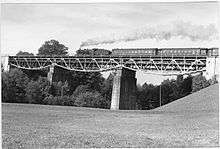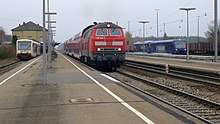Allgäu Railway (Württemberg)
The Württemberg Allgäu Railway (German: Württembergische Allgäubahn) is a single-track non-electrified railway in the German state of Baden-Württemberg from Aulendorf via Bad Waldsee, Kißlegg, Leutkirch to Isny. Since the Leutkirch–Isny railway is no longer in operation, the term Württembergische Allgäubahn is now used by Deutsche Bahn only to describe line 753 in its timetable (Aulendorf–Kißlegg) and the adjacent Kißlegg–Hergatz railway from Kißlegg via Wangen to Hergatz in Bavaria. The section from Kißlegg to Leutkirch belongs to line 971, which includes the line from Augsburg to Lindau. Historically, the Herbertingen–Aulendorf line has sometimes been included in the Württemberg Allgäu Railway.
| Aulendorf–Leutkirch | |||||||||||||||||||||||||||||||||||||||||||||||||||||||||||||||||||||||||||||||||||||||||||||||||||||||||||||||||||||||||||||||||||||||||||
|---|---|---|---|---|---|---|---|---|---|---|---|---|---|---|---|---|---|---|---|---|---|---|---|---|---|---|---|---|---|---|---|---|---|---|---|---|---|---|---|---|---|---|---|---|---|---|---|---|---|---|---|---|---|---|---|---|---|---|---|---|---|---|---|---|---|---|---|---|---|---|---|---|---|---|---|---|---|---|---|---|---|---|---|---|---|---|---|---|---|---|---|---|---|---|---|---|---|---|---|---|---|---|---|---|---|---|---|---|---|---|---|---|---|---|---|---|---|---|---|---|---|---|---|---|---|---|---|---|---|---|---|---|---|---|---|---|---|---|---|
| Overview | |||||||||||||||||||||||||||||||||||||||||||||||||||||||||||||||||||||||||||||||||||||||||||||||||||||||||||||||||||||||||||||||||||||||||||
| Locale | Baden-Württemberg, Germany | ||||||||||||||||||||||||||||||||||||||||||||||||||||||||||||||||||||||||||||||||||||||||||||||||||||||||||||||||||||||||||||||||||||||||||
| Line number | 4550 (Herbertingen–Isny) | ||||||||||||||||||||||||||||||||||||||||||||||||||||||||||||||||||||||||||||||||||||||||||||||||||||||||||||||||||||||||||||||||||||||||||
| Technical | |||||||||||||||||||||||||||||||||||||||||||||||||||||||||||||||||||||||||||||||||||||||||||||||||||||||||||||||||||||||||||||||||||||||||||
| Line length | 40.6 km (25.2 mi) | ||||||||||||||||||||||||||||||||||||||||||||||||||||||||||||||||||||||||||||||||||||||||||||||||||||||||||||||||||||||||||||||||||||||||||
| Track gauge | 1,435 mm (4 ft 8 1⁄2 in) standard gauge | ||||||||||||||||||||||||||||||||||||||||||||||||||||||||||||||||||||||||||||||||||||||||||||||||||||||||||||||||||||||||||||||||||||||||||
| Route number | 753 (Aulendorf–Kißlegg) 971 (Kißlegg–Leutkirch) | ||||||||||||||||||||||||||||||||||||||||||||||||||||||||||||||||||||||||||||||||||||||||||||||||||||||||||||||||||||||||||||||||||||||||||
| |||||||||||||||||||||||||||||||||||||||||||||||||||||||||||||||||||||||||||||||||||||||||||||||||||||||||||||||||||||||||||||||||||||||||||


History
In 1860, a so-called Eisenbahn Comite (railway committee) was established with the aim of having the cities of Leutkirch and Isny connected to the network of the Royal Württemberg State Railways (Königlich Württembergischen Staats-Eisenbahnen). On 13 August 1865, the lower house of the parliament of Württemberg (württembergische Abgeordnetenkammer) finally approved the construction of a line from Herbertingen via Saulgau, Aulendorf, Waldsee, Kißlegg and Leutkirch to Isny. This was opened in five sections as follows:
| 25 July 1869 | Saulgau–Aulendorf–Waldsee | 28 km |
| 10 October 1869 | Herbertingen–Saulgau | 9 km |
| 15 September 1870 | Waldsee–Kißlegg | 20 km |
| 1 September 1872 | Kißlegg–Leutkirch | 11 km |
| 15 August 1874 | Leutkirch–Isny | 16 km |
In Aulendorf, the new line crossed the Württemberg southern railway (Württembergische Südbahn), running from Ulm to Lake Constance. With the construction of the Württemberg Allgäu Railway, Aulendorf became an important railway junction for Upper Swabia.
Passenger services

Under the Allgäu-Swabian regular interval timetable (Allgäu-Schwaben-Takt) introduced in 1993, passenger services on the Aulendorf–Leutkirch–Memmingen route became hourly. In the 2005 timetable services were thinned out to run every two hours—supposedly because of insufficient numbers of passengers. These figures are disputed. Studies show an increase in ridership of 386% on the Aulendorf–Kißlegg–Memmingen route between 1993 and 2003.
Since early 2005, there has been an initiative called Allgäubahn im Stundentakt (hourly services on the Allgäu railway) that aims to restore the hourly service on the line. It achieved a partial success in the timetable change in December 2005, with the restoration of some services for commuters and school transport. In October 2006, the Initiative Allgäubahn was founded to campaign for improvements to the perceived inadequate basic two-hour interval service for the cities and municipalities on the Württemberg Allgäu Railway and the Kißlegg-Memmingen line. The mayor of Kißlegg, Dieter Krattenmacher coordinated the initiative and as a first step commissioned an opinion from the Tübingen-based transport consultant Ulrich Grosse, who proposed a concept with buses no longer running parallel to the railway line, but instead running at right angles to it. This was realised in the 2007/2008 timetable change for Aichstetten and in the summer of 2008 for the Kißlegg/Bad Wurzach area.
Since the timetable change to the winter timetable of 2011/2012, the timetable has returned to an approximately hourly service, but there remain gaps in the less busy times of the day. Baden-Württemberg's new Minister of Transport, Winfried Hermann has continued to finance the additional services that are required because of the loss of revenue due to the failure of tilting technology, among other things.
Freight
In the 21st century, freight transport has been limited mainly to the delivery of raw materials for the Saint-Gobain glass plant in Bad Wurzach, with trains continuing over the Roßberg Railway. Gravel trains also operate in the summer and the Shell tank farm in Aichstetten-Altmann Mayrhofen is also served.
The future
On 15 February 2008, the German Minister of Transport, Wolfgang Tiefensee and his Swiss counterpart, Moritz Leuenberger signed a Memorandum of Understanding (MoU) in Memmingen agreeing to upgrade the Munich–Lindau railway and electrify it between the current ends of electrification at Geltendorf and Lindau-Aeschach. The Leutkirch–Hergatz section of the Württemberg Allgäu Railway is part of the upgraded line. The MoU was followed on 18 December 2008 by a statement on its financing. This project is related to the construction of the Gotthard Base Tunnel. In particular, Switzerland wants the Munich–Buchloe–Memmingen–Lindau–Bregenz route to be a feeder line for the new route. The expansion will allow a reduction in times for passenger trains between Munich and Zurich from four hours to only three hours. Work was originally expected to begin in 2010 and it was expected to be completed in 2015.
The electrification of the line and its upgrade for tilting trains was originally estimated to cost the federal government about €210 million. Bavaria would provide finance of €55 million and Switzerland would have granted an interest-free loan of €50 million. The Swiss loan in expected to be granted in spite of the delay as the deadline for all access routes of the Gotthard Base Tunnel has been extended by five years. On 18 October 2012, Deutsche Bahn announced that the start of construction would be delayed indefinitely because of unexpected increases in costs of €88 million, raising total costs to €298 million. As a result, there would have to be new funding negotiations. Moreover, Deutsche Bahn does not currently have a long-distance train that is equipped with tilting technology and is approved to run on this route. So rolling stock using Swiss technology would be allowed to operate on the route.[2]
Notes
- Eisenbahnatlas Deutschland (German railway atlas). Schweers + Wall. 2009. ISBN 978-3-89494-139-0.
- Aimée Jajes (19 October 2012). "Elektrifizierung der Strecke München-Lindau wieder verschoben". Augsburger Allgemeine (in German). Retrieved 26 January 2013.
References
- Thomas Scherer (1981). Eisenbahnen in Württemberg (in German). I: Die württembergische Allgäubahn. Ulm.
External links
| Wikimedia Commons has media related to Württemberg Allgäu Railway. |
- "Pendlerinitiative Allgäubahn im Stundentakt" (in German). Retrieved 3 February 2012.
- "Württemberg Allgäu line in 1944 timetable" (in German). Retrieved 3 February 2012.